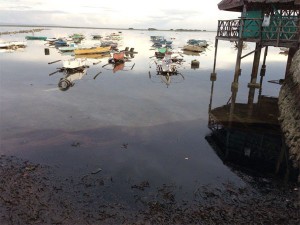
Oil leaking from the MV St. Thomas Aquinas, which sank after colliding with a cargo ship off Talisay City in Cebu, reaches the shores of Cordova town 5 kilometers away. PHOTO FROM OFFICE OF CEBU REP. LUIGI QUISUMBING
CEBU CITY—Local officials have raised concerns over the fuel leak from the sunken MV St. Thomas of Aquinas, as oil spread to coastal villages, fishing grounds and mangroves more than five kilometers from the site of Friday’s accident.
Among the areas affected were Lapu-Lapu City and Cordova town on Mactan island and Talisay City in Cebu, which all host popular beach resorts.
The St. Thomas of Aquinas of 2GO Travel was carrying 20 tons of diesel oil and 120 tons of bunker oil when it sank on Friday night in the vicinity of Lawis Ledge, Talisay City, after colliding with the cargo vessel MV Sulpicio Express Siete.
The authorities were focused Sunday on trying to find the missing passengers of the ferry, which is about 30 meters under water, but the leaking oil added a new front to the disaster response.
Eleven of the 13 barangays (villages) of Cordova town have been affected by the oil slick, covering about three hectares and endangering the livelihood of about 5,000 fishermen in the coastal municipality.
According to Ensign Jaypee Abuan, information officer of Naval Forces Central, the divers saw thick black oil coming from the sunken vessel on Sunday morning.
The oil, Abuan said, floated to the surface and mixed with the seawater, turning milky brown in color “similar to three-in-one coffee.” The water also smelled like iron rust.
Cordova Mayor Adelino Sitoy and members of the Marine Watchers inspected the affected areas Sunday morning and saw the damage to fishing, the town’s primary means of livelihood. The mayor said he was afraid the oil slick would severely affect the town’s number one seafood delicacy, saltwater eel, locally known as “bakasi.”
Barangay Gabi, where a fish kill was reported, was most affected.
Sitoy said the fishermen told him they went home with their fish, shell and other sea produce coated in oil.
“The fishermen also complained that their pump boats were covered with oil. They cannot eat or sell their catch. We will go hungry because of this,” said Sitoy.
Cordova is a fishing community fronting Talisay City on the Cebu mainland.
Sitoy said the oil slick should have been contained had the sunken ship carried a containment boom that would float to dissolve the oil in case of a sea mishap.
He said they had tapped the services of Greener Products and General Services, a private company, to help them clear Cordova’s waters of the oil slick.
In Lapu-Lapu City, Mayor Paz Radaza was prompted to convene the crisis management committee and meet with the different executives of the resorts.
“We have given them tips on how to address a possible oil sheen on their respective properties. I also asked them to do their share of protecting their properties. We are also conducting oil sweeping operations in some areas,” he said.
Radaza said they had deployed two kilometers of an improvised spill boom made of recycled plastic materials that would be distributed to the different stakeholders who would do coastal cleanup.
Cebu Coast Guard station commander Weniel Azcuna said they had yet to conduct an aerial inspection to check the extent of the damage caused by the oil spill.
“It has affected a lot of shorelines here in Cebu and [the neighboring island of] Mactan,” Azcuna said.
He said there were about 120,000 liters of bunker fuel, and divers had been unable to reach the source of the leak.
“You can see it coming out of the sunken vessel. It is bunker fuel and it is black,” Azcuna told Agence France-Presse.
Commodore William Melad of the Philippine Coast Guard in Central Visayas said they planned to place oil spill booms around the sunken ship if the sea conditions would allow it.
He said the divers had been tasked to plug the leak from the vessel to prevent more oil from coming out.
They had already sprayed chemical dispersant around the area to prevent the oil slick from spreading, he added.
2GO also engaged the services of Malayan Towage, an expert in oil spills.—With reports from Jhunnex Napallacan and Carmel Matus, Inquirer Visayas; AFP
RELATED STORY
Oil spill reaches Mactan shoreline